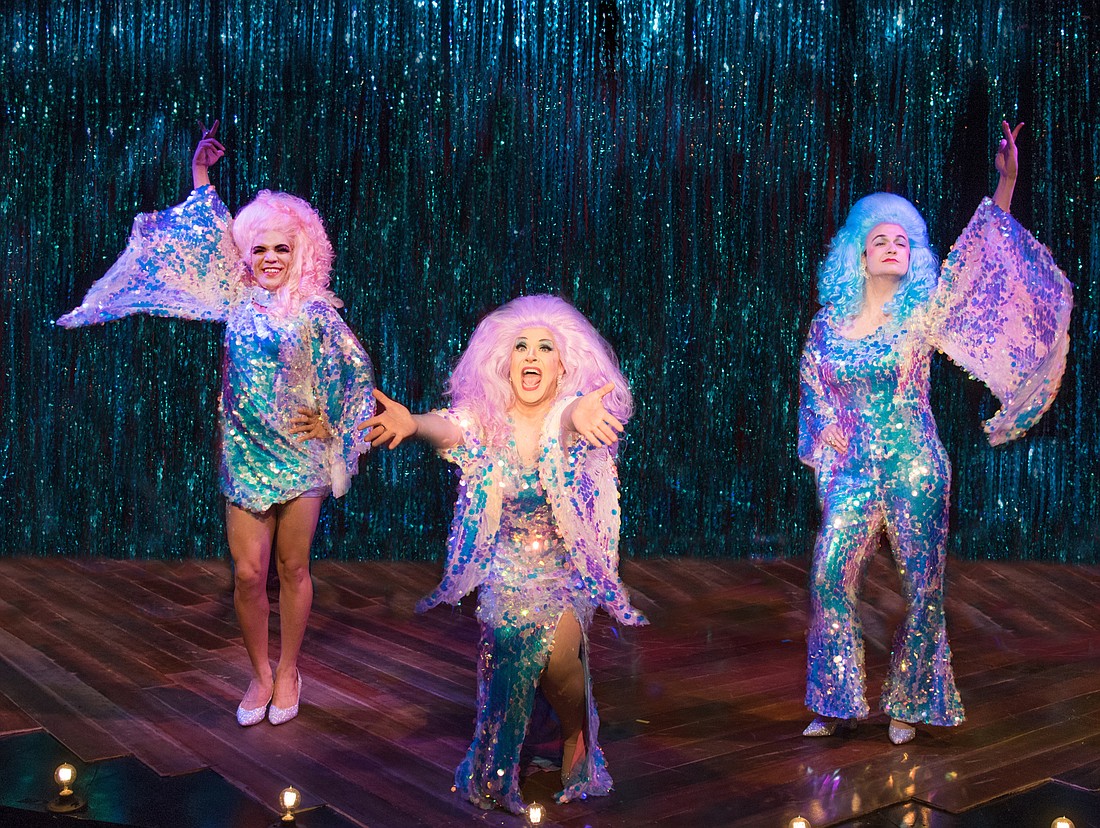- April 2, 2025
-
-
Loading

Loading

At best, costume designers get a line or two in a typical play review. But in the world of live theater, their work is vital.
Without them, the actors would all be nude. OK, even a lousy costume designer can fix that.
But a great designer helps the actors transform into their characters.
That’s true for every play. But with “The Legend of Georgia McBride,” that transformation is the heart of the story.
The Matthew Lopez comedy follows an Elvis impersonator who’s dethroned as The King and becomes a hit as a drag queen.
In spring 2020, FST was gearing up to stage this show. The actors had wrapped their first week of rehearsals. Lea Umberger was tweaking her original costume designs. Showtime was just around the corner!
Until the pandemic crashed the party. And Elvis left the building.
Now it’s a new year, a new spring, and “Georgia McBride” has been born again. Mari Taylor Floyd is FST’s new costume shop supervisor and the show’s associate costume designer.
What’s the job description? Simple. From nightgowns to jumpsuits, if an actor is wearing it, it’s Floyd’s responsibility.
No pressure. Just the success or failure of this production.
In June of 2021. When Lea had to step away, I also took on the “Georgia McBride” project. That’s when I became the production’s associate costume designer.
Definitely. If you do the math, there are a total of 50 costumes — with 27 in the drag look. We’ve also got 24 wigs in production.
No, I’d been working with Lea throughout the year — our collaboration was a great experience. She’d already created the basic design concepts for this show. Before she left, she said: “I don’t want you in the dark on this. Before I go, let’s sit down for two hours. We’ll go through every single costume and the creative choices behind it.” So that’s what we did. And then she handed the project over to me.
Well, we tried to stick to Lea’s original design intentions as much as we could.
Realistically, that’s not always possible. A design might look amazing on paper. But these things morph in live theater.
You meet the new actors and watch the show taking shape in the rehearsal room — and that changes everything. You see what the director’s actually trying to conceive in the show. What works and what doesn’t.
Characterization, obviously. And time.
Yeah. From scene to scene, the time for costume changes is very limited. We sometimes have to simplify the designs to accomplish it. And the designs are specific to each actor. That applies to wigs, too. Put a towering wig on a big actor and he’s suddenly eight feet tall. An inch or two taller, and the wig’s a fire hazard. So you have to make those calculations.
That actually happened on this show. And the lighting designer hates me for it. The actors all love me, so that’s OK.
Well, actors create and become their characters. That’s their job — and the right costume helps them do that. It’s something specific they can wrap their minds around. A suit, a dress. … It helps them visualize what their characters look like. And who they are.
Well, that’s Casey, the Elvis impersonator — who’s hilariously played by Britt Michael Gordon. But Georgia McBride is also the main character. (Britt plays her too; she's Casey's drag persona.) So, Casey transforms into Georgia and becomes her all the way.
You got it. That’s a big part of the story. In a greased-back wig and gold lamé jumpsuit, Casey turns into Elvis. In a pompadour wig, he turns into a beautiful woman. It’s all about transformation.
It is a ton of fun — but there’s also a ton of painstaking calculations.
Costume design is like any other form of design. The specifications can be very narrow.
Your first design doesn’t always work — or your second or third design — and that can get frustrating. Like the Elvis wig in this show. How hard could that be? But Susan Haldeman, our wig designer, went through constant trial-and-error perfecting that design.
If the wig hangs flat, you’ve got Moe from the Three Stooges. If the wig’s too comical, you wind up with Camp Elvis — and that’s not the vision for this play. So Susan kept going back to the drawing board until she finally got it right. That’s her process, and mine too.
If you’re a costume designer, you can’t just fool around, even if you want to.
I’m constantly stifling my inner child. “No! You can’t do that!”
No. Creating a Dolly Parton drag performer’s dodgeball-sized boobs was easy.
Dodgeballs. (laughs)
I really love my work as a costume designer. It's a beautiful whirlwind of craziness!
The interns, absolutely. They’re the backbone of Florida Studio Theatre.
And the interns working on “Georgia McBride” are rock stars. We call them “The Glam Squad” — and they’re amazing.
This show has so many costumes, so many changes. We couldn’t make it happen without them!